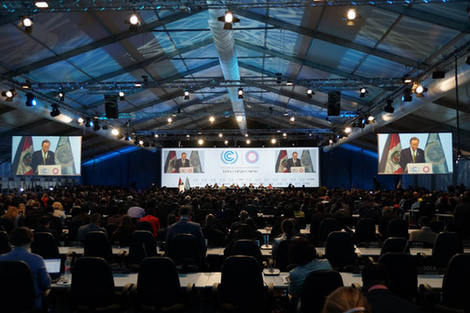Lima Climate Change Conference: Compromise Limits Achievements
By staff reporter LI WUZHOU
The annual United Nations Climate Change Conference, held in Lima, capital of Peru, finally concluded in the small hours of December 14, 2014, after running more than 32 hours over schedule.
There were gaps in the General Assembly’s adoption of a final resolution, but it reached a consensus on elements of the draft agreement expected to be passed at the Paris climate change conference in December 2015.
Disappointing presentations from developed countries and more compromises from developing countries were at the root of this lame result. “Even though developing countries’ capacity for and control of global governance are on the ascent, their right of discourse is, on the whole, relatively weak,” deputy director of the National Center for Climate Change Strategy and International Cooperation Zou Ji said.
|
 |
|
UN Secretary-General Ban Ki-moon at the high-level segment of the climate change conference on December 9, 2014, urging negotiators to take united action to produce a balanced and coherent draft text vital for a binding climate agreement in Paris in 2015. |
Imperfect but Acceptable
As a key point of the multilateral climate negotiation process, the aim of the Lima conference was to encourage all parties to exchange views on elements of a new deal to tackle climate change after 2020. The conference committed to paving the way to the 2015 Paris conference, and to urging all parties to bring previous consensuses into effect and so launch the Green Climate Fund as soon as possible.
The Lima conference agreed on two deliverables: the Lima Call for Climate Action and the draft 2015 agreement. It thus narrowed the cognitive gaps among various countries and reached a simple and clear decision. This is undoubtedly good news for the Paris conference.
However, the draft text is unsatisfactory due to developing countries’ compromises and developed countries’ reneging on their commitment to emissions reduction and financial support. Conspicuous in its absence was the latter’s roadmap for the pledged yearly US $100 billion in climate aid up to and including the year 2020.
The European Union (EU) stated on December 14 that the outcome of the Lima conference represents a step forward to a global climate deal in Paris in 2015. Certain environmental protection organizations, meanwhile, criticized the result as “greatly reduced” and “nothing to brag about.”
The outcome, however, was within the Chinese delegation’s expectations, according to deputy chief of the National Development and Reform Commission (NDRC) Xie Zhenhua, who headed the Chinese delegation to Lima. “We’re not entirely satisfied with the outcome, but believe it is balanced, and fundamentally meets the requirements of developing countries,” Xie said after the meeting.
